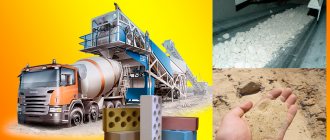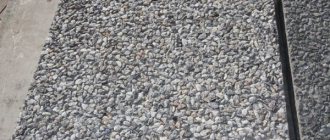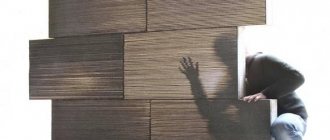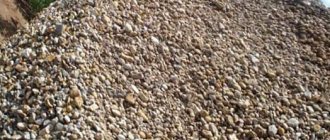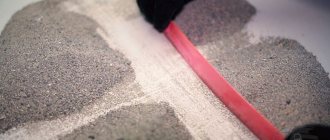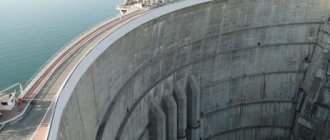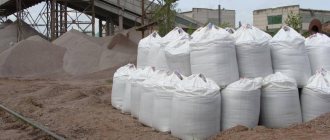Real estate
00:00, 01/11/2021 8 Plot: House in focus
Advantages and disadvantages of wood concrete, GOSTs, secrets of choice
Photo: srbu.ru
Another material, hitherto not mentioned in the “House in Focus” project, that is used to build houses in our country is wood concrete (it is also sometimes called wood concrete). It’s hard to call it a novelty - it was made in the USSR back in the 1960s, and there is even a story that it was used to build a canteen at a Soviet polar station. Whether it was true or not is difficult to verify. However, wood concrete blocks occupy their not the largest, but strong place in the market of materials for private housing construction. We invite you to get to know him better.
How to make wood concrete
Strictly speaking, it is also considered lightweight concrete, but 80-90% consists of wood chips and chemical binders. The remaining 20-10% is a cement binder. Instead of chopped wood, fire plants (flax, hemp) and even rice straw can be used. In short, any dense plant material is suitable, but wood concrete for construction is still mainly made from wood filler.
The technical conditions for the production of this material are regulated by GOST R 54854-2011. Portland cement (including its fast-hardening variety) is used as a binding material; the filler is most often coniferous wood chips (pine, spruce, larch).
Chemical additives (calcium chloride, liquid glass, lime, alumina sulfate) must be introduced into the wood concrete composition. Firstly, such additives accelerate hardening and improve the protection of reinforcing steel from corrosion. Secondly, they bind sugars contained in natural wood and prevent the development of putrefactive processes inside the material - they mineralize the contents of the block. Another type of additive is pore-forming (to ensure drying of the blocks and their ventilation). Arbolite structures are reinforced. For this purpose, fittings of classes AI, A-II, A-III of small diameter (up to 16 mm) are used.
Methods for forming blocks and slabs from wood concrete can be different: this happens in metal forms, the material in them is either rolled layer by layer, or pressed, or compacted on vibrating platforms - in a word, there are many ways.
There is also the so-called monolithic wood concrete, when the material is mixed and poured directly on the construction site into permanent formwork. This technology is quite exotic, but it completely eliminates the formation of cold bridges and allows the implementation of the most fantastic architectural forms. And in order to avoid the formation of cold bridges when using conventional blocks and slabs, builders use a heat-insulating masonry mixture, which has the same thermal conductivity as the wood concrete itself.
Wood concrete is also considered lightweight concrete, but 80-90% consists of wood chips and chemical binders. Photo: z500proekty.ru
Problematic points
We list the disadvantages of wood concrete, which are more than enough:
- Propensity to ignite products consisting of 80-90% wood pulp.
- Non-standard dimensions associated with increased dimensional tolerances.
- Reduced resistance to moisture.
- Difficult finishing, which can cause condensation and mold.
- Unstable product quality due to production features.
- Easy ventilation of blocks that require powerful wall insulation.
- Features of the composition that cause unpleasant odors.
Let's look at each disadvantage separately.
Arbolite blocks can easily ignite
Dry numbers
Wood concrete, like many other wall materials for building a house, can be of different classes in terms of compressive strength. For structural wood concrete, it must be at least B1 (this corresponds to a density of 650-750 kg/sq. m). The maximum class of wood concrete in terms of compressive strength is B3.5 (800-850 kg/sq. m).
According to the table given in GOST, for load-bearing walls made of wood concrete, the average density grade should be D750-D900, the compressive strength should be B2.5 and B3.5. Curtain walls can be limited to D500-B600, compressive strength - from B0.75 to B1.5.
The grade of wood concrete in terms of frost resistance for buildings with indoor humidity from 60 to 75% should be at least F35 (or better - 50).
The humidity of wood concrete brought to the site should not be more than 25% by weight.
Arbolite blocks and panels, in accordance with SN 549-82, are intended for the construction of external and internal walls for buildings in which the relative air humidity will not exceed 75%, without exposure to aggressive environments. The range of systematic temperature exposure should be from 50 to -40 degrees Celsius.
Thus, we can conclude: wood concrete walls are quite suitable for the construction of a residential building in our latitudes. To do this, the walls are laid out in one row of blocks measuring approximately 500x300x200 mm. Wall surfaces that come into contact with atmospheric moisture must be reliably protected from moisture and from blowing with a finishing layer. For example, warm plaster systems up to 2 cm thick with the addition of perlite are well suited for this.
Arbolite walls are quite suitable for the construction of a residential building in our latitudes. Photo: z500proekty.ru
Arbolit: pros and cons, professional opinion
Regarding the pressing issue of external finishing of wood concrete, reviews from professional builders were as follows :
Finishing, implemented with the participation of plaster mixtures, a finishing layer of vapor-permeable materials, a blockhouse or imitation timber, or any type of ventilated facades, best corresponds to the properties of this material. Practice has shown that bathhouses, houses, outbuildings and garages have easily withstood all impacts without finishing for several years. However, it is still advisable to build external protection in order to reduce moisture absorption, increase durability, and frost resistance.
In addition, it is recommended to take into account that when building from monolithic wood concrete, you can use a material with a density of 300 kg/m³ and higher, which corresponds to the density of a wall made from a small-piece block of 500-550 kg/m³.
A conditional disadvantage can be considered the presence of shrinkage phenomena. However, this is a shrinkage not of the material itself, but of the wall structures themselves, including the masonry mortar that is under load. It is recommended to carry out plastering work no earlier than 60 days after the completion of the construction of the box under the roof.
Advantages of wood concrete
Like any other building material, wood concrete has a number of advantages and a list of disadvantages. Let's start with the advantages.
Firstly, it has excellent thermal insulation. Due to the content of wood chips and a large number of pores, wood concrete has low thermal conductivity and retains heat well. True, for this it is necessary that the material be produced strictly in accordance with GOST (see above).
Secondly, it is lightweight. A cubic meter of wood concrete weighs approximately 650 kilograms - about the same as aerated concrete or pine beams. And, as with any other lightweight material, this provides serious savings on the foundation.
A cubic meter of wood concrete weighs approximately 650 kilograms - about the same as aerated concrete or pine beams, and this provides serious savings on the foundation. Photo: kblok.ru
Thirdly, the volume of the wood concrete block is quite large - similar to about 15 standard bricks. And this significantly speeds up the process of building a house and allows you to save on labor. Among other things, working with wood concrete is not very difficult, so you won’t have to get lost in search of a team “tailored” specifically for this material (as, for example, in the case of gas silicate blocks).
Fourthly, the geometry of the wood concrete blocks can be changed as you please - the material can be easily cut with a regular chainsaw. Rumor has it that even a hacksaw can handle it. And once you move into a house made of wood concrete, you can easily hammer nails into such walls.
Fifthly, wood concrete has a fairly high sound absorption coefficient. Acoustics of wood concrete, according to the results of a study conducted at Siberian State University named after. Reshetnev, showed a sound absorption coefficient from 0.17 to 0.6 at sound frequencies of 125-2000 Hz. For example, a brick at a frequency of 1000 Hz shows a sound absorption coefficient of 0.04.
Sixth and seventh, despite the fact that wood concrete consists almost entirely of wood, it is devoid of its main disadvantages - flammability and biodegradability. To set fire to a wood concrete wall, you have to seriously try; it has a low flammability class - G1. During an hour of fire, wood concrete is charred by no more than 30 mm. And due to the content of mineralizing additives and cement, the arbolite wall is not at all attractive as a food product either for macrofauna (bugs or mice) or for microorganisms (you will not see rot on the blocks).
The geometry of the wood concrete blocks can be changed as you please - the material can be easily cut with a regular chainsaw. Photo: z500proekty.ru
Positive and negative reviews about houses
Users on the network highlight the following advantages of wood concrete blocks:
- Non-flammability.
- Naturalness.
- Good level of heat conservation.
- A light weight.
- Easy to build walls.
- Environmentally friendly.
- Affordable price.
- Possibility of do-it-yourself production.
The disadvantages in the reviews are as follows:
- The need for exterior finishing due to the high level of moisture absorption by the blocks.
- Dimensions are not always ideal; the geometry of the blocks may not be respected.
- Inability to build tall buildings.
You can read more about people’s opinions about wood concrete blocks here, here and here.
Flammability
The use of wood chip-based blocks can lead to fatal consequences in the event of a fire. Small advertisements from manufacturers show the resistance of the blocks to open fire.
Indeed, wood concrete does not ignite for several minutes. However, at high temperatures, smoldering will inevitably occur with fatal consequences. It is difficult to say that the material will maintain its integrity and that the house will not have to be rebuilt after a fire.
Compound
The wood concrete mixture may contain various components. According to GOST 19222-84, wood concrete must consist of several components.
Organic filler – wood chips. To obtain quality blocks, wood particles with dimensions not exceeding 30, 10 and 5 mm in length, width and thickness, respectively, should be used. In addition, the content of polysaccharides in wood should not exceed 2%. The organic filler should not contain fungal elements or various mechanical inclusions. Depending on the type of wood concrete, the wood chip content ranges from 75 to 90%.
Cement binder. Portland cement of a grade not lower than M400 should be used as such a filler. Some manufacturers offer blocks made from frost-resistant cement. It should be noted that during long-term storage, cement blocks lose their original characteristics, which is why they may not meet the requirements stated by the manufacturer.
To avoid such a problem, experienced builders recommend buying wood concrete made of cement no lower than grade M500.
Components of chemical origin. Arbolite blocks partly consist of organic fillers, which tend to rot. To avoid damage to wood chips by fungus, various chemical additives are added to the mixture. These may be calcium or ammonium chlorides, aluminum sulfate or other inorganic substances. Such components are harmless to human health. They allow not only to protect wood chips from premature deterioration, but also to speed up the process of adhesion of the components of the wood concrete mixture, while reducing the drying time of the blocks.
Water is also used to create wood concrete. Its quality is regulated by GOST 23732-79. The water should not contain fats, lipid derivatives, or coloring components. Only fresh liquid is used to produce blocks.
Before starting the technological process, water and chemical components are subjected to laboratory tests. They are carried out regularly for each newly received batch.
| Wood concrete brand | Cement(M400) | Quantity of lime | Quantity of sand | Number of sawdust | Resulting density, (kg/m3) |
| 5 | 1 | 1,5 | — | 15 | 300-400 |
| 10 | 1 | 1 | 1,5 | 12 | 600–700 |
| 15 | 1 | 0,5 | 2,5 | 9 | 900–1000 |
| 25 | 1 | — | 3 | 6 | 1200–1300 |
Flaws
Arbolite has many advantages, and slightly fewer disadvantages.
The main disadvantage is the high risks of purchasing homemade modules. The fact is that high-quality blocks are produced at large manufacturing enterprises, which cannot be found in the region. Such manufacturers do not think about the performance qualities of the building materials they produce. They make modules, disrupting the technological process. As a result, they sell wood concrete whose technical characteristics are significantly lower than stated.
Another disadvantage is the low density of the material. On the one hand, this is a positive point, since the load on the foundation is reduced, but on the other hand, such blocks cannot be used for the construction of multi-story structures.
There are a number of other disadvantages of this material.
- Size deviations. Finished blocks can vary significantly in the standard sizes prescribed by the regulations. Sometimes, due to inconsistencies in parameters, builders have to increase the thickness of the seams. This leads to the formation of “cold bridges” and freezing of the seams in cold weather.
- Biological instability. Wood concrete blocks are products that are “loved” by rodents. Mice and rats make numerous holes and passages in them, which significantly reduces the service life of the building. To protect the structure from such pests, you will need to make a concrete basement. And this means additional money spent on building materials and hiring a construction crew.
- The need for decorative finishing of the facade. Wood concrete is an aesthetically unattractive building material (unless we are talking about products with cladding). To improve the appearance of a building, you cannot do without finishing. This will entail the cost of purchasing cladding and hiring labor.
- Weak resistance to high humidity. Arbolite blocks are capable of accumulating moisture, which over time destroys the material. In order for a building made of wood concrete to last as long as possible, you need to make a foundation with a good waterproofing shell and plaster the outer part of the wall.
- High price. We are not talking about low quality handicraft blocks here. Products that comply with GOST standards are not cheap. Their price is approximately 1.5 times higher compared to the cost of aerated concrete or foam block.
Some disadvantages of wood concrete are associated with violations of its production technology or with the use of low-quality components. In order not to purchase blocks that are unsuitable for construction, you need to listen to some recommendations.
Quality deviations
The following factors affect product quality:
- features of the ingredients used;
- the manufacturer’s desire to gain additional profit and increase production profitability;
- violation of technology;
- deviations in the recipe.
Taken together, this leads to undesirable consequences. In particular, a decrease in the concentration of lime is the cause of the development of rot, and the use of low-quality cement causes a decrease in strength.
No. 6. What to consider when choosing wood concrete?
There are a lot of manufacturers of wood concrete blocks today; we will not single out anyone in particular, since there are worthy companies in each region and it would take a very long time to list them. On the other hand, everywhere there are a lot of handicraft industries that try to sell frankly bad goods at a higher price, and even a quality certificate is not always a guarantee of actual quality, because we all know how documents are sometimes made. It is best to visit the production site and evaluate the technology and quality of the blocks with your own eyes. What criteria should be used to check and how to understand that the product is of poor quality?
First of all, attention must be paid to the wood chips. GOST regulates its parameters 40/10/5, i.e.
it should be rectangular in shape and large enough; one block should contain chips of approximately the same size. Square-shaped chips will not provide a normal bond, and small sawdust will not provide high-quality thermal insulation. Machines that make oblong chips are several times more expensive than units that make square chips, especially since the latter can be obtained for free at almost any woodworking plant. It would be better if pine chips were used.
Externally, an arbolite block cannot be absolutely smooth. On the contrary, the ideal surface is characteristic of blocks made using sawdust and square chips, and the smooth surfaces of such blocks confuse buyers.
All sides of the block must be the same. If one end of the product is smooth, and the rest are very different from it, then the production technology was violated and the cement flowed down. This block is not suitable for construction. There should be no white coating on the blocks (indicative of adding glue or pouring milk down), and the wood chips should not be picked out by hand (indicative of poor adhesion).
The geometry of the blocks must be respected, the maximum permissible deviation is 5 mm. Cement should be used grade M500. Give preference to blocks produced using vibration compaction - manual tamping does not allow you to achieve the required strength. It is better if the blocks are kept in molds for 24 hours. If instant formwork is used, the geometry of the blocks may be significantly disrupted.
Application of arbolite blocks
The building material in question is used:
- When working on the construction of load-bearing walls of low-rise residential buildings /no more than three floors/.
- During the construction of non-residential premises.
- During thermal insulation work.
Wood concrete, like other materials, has its positive and negative sides.
Common mistakes during construction
- Poor quality of purchased blocks, violations during their manufacture or when pouring monolithic wood concrete. This can lead to shrinkage, changes in wall geometry and loss of strength.
- Construction of the basement walls of a house from unsuitable material, for example, cellular concrete. In this case, the wood concrete will not be protected from moisture.
- Lack of reinforced belt under the floors.
- Protection of metal elements from corrosion was not provided.
- The arbolite blocks were not watered before installation.
- The use of thermal insulation blocks instead of structural ones.
- Use of wood concrete in rooms with high humidity without additional protection.
- Sloppy, unprofessional assembly of arbolite walls, in violation of current building codes and regulations.
In order to avoid mistakes when building a house, you need to thoroughly study all aspects of this matter and make a house from wood concrete with your own hands or entrust the construction to professionals. It will be useful to check the quality of incoming materials, as well as to have a clear technical specification and building design. Thus, it will be possible to build a high-quality and comfortable home!


